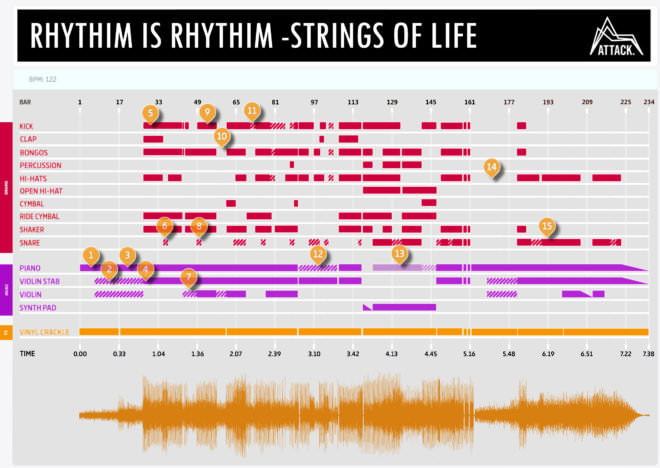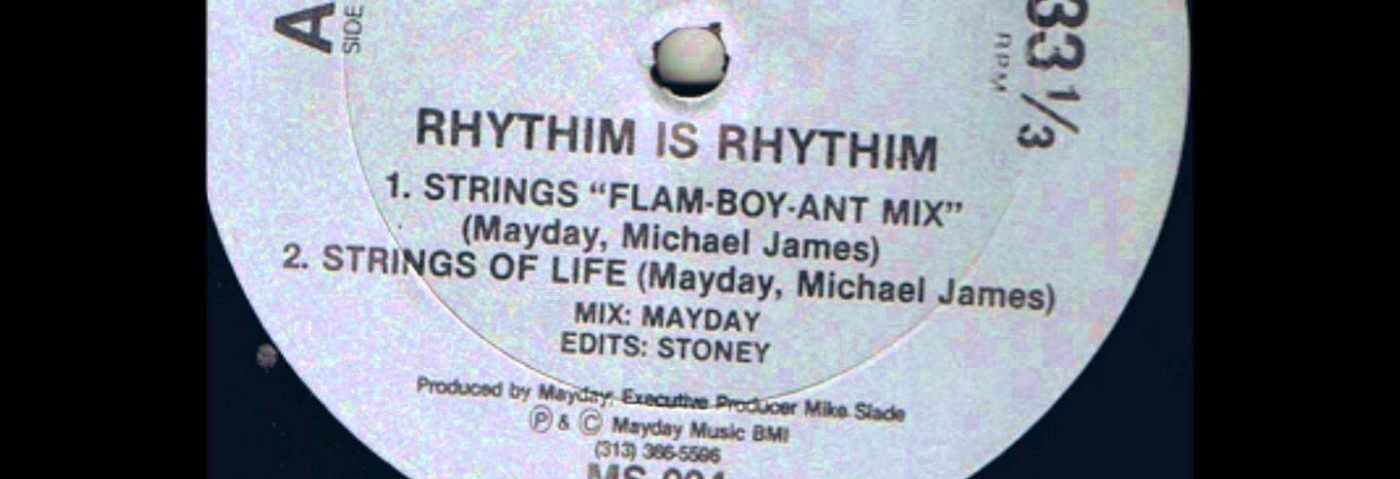We break down the arrangement of Derrick May’s undisputed 80s classic.
The boundary between house and techno has always been nebulous at best, but nowhere is that more evident than in the earliest days of the Detroit techno scene. Derrick May’s iconic ‘Strings Of Life’, released in 1987 under his Rhythim Is Rhythim alias, is the perfect example, blurring the lines between electronic soul and futurist funk.
The Track
THE ARRANGEMENT

(Click to enlarge.)
WHAT’S HAPPENING?
- The track opens with the instantly recognisable piano chords that underpin the track. The chords are very much the bedrock of ‘Strings Of Life’, but Derrick May openly admits to not having written or recorded them himself. The story goes that May’s friend Michael James was visiting Derrick in his home when he noticed the studio and recorded a piano part. May held onto the sequence and stumbled upon it a year later, which is when he decided to create a full track using sections of his friends recording. The keyboard was probably a mid 80s Kurzweil digital piano with an inbuilt sequencer, which would explain how May was able to recall his friend’s recording so easily a year later.
- The stabbing strings emphasise the first beat of the phrase with their strong attack, and continue to fill the sections in between each hit with a quieter sustain. The strings almost certainly come via an Ensoniq Mirage, a relatively basic 8-bit sampler keyboard with a distinctive lo-fi sound.
- We hear a slight variation in the piano chord, with a rise in octave which anticipates the drums. The octave change catches the listener’s ear to make them aware of the unsubtle but simple variation, breaking up the sequence.
- The string sample is layered with a similar sounding synth which add more attack, making the hits even more prominent and aggressive.
- The string synth varies slightly, breaking up the monotonous piano riff and keeping the listener guessing. The random rhythm builds up excitement and provide quick pangs of emotion. There seem to be some variations in the envelope settings on the string synth, softening the attack and creating quieter hits. Similar effects might also have been created with an outboard effect such as a gate or transient shaper.
- The highly anticipated drums finally come in with a thumping four-to-the-floor kick drum and shaker. The high frequencies in the shaker are rather piercing but raise the energy in the track significantly, whereas the kick dominates the low end with a warm and rounded pulse. The string and synth layer fall into a more constant rhythm.
- A snare drum roll fills in the next two bars for variation. Notice how there is no bassline in this track, so the variation in the instruments is crucial to the groove of the song. The string and synth layer continue in their fast rhythm.
- The strings are now being played in a sustained style again for two bars, as the synth continues to play staccato hits. This is followed by a small break in the drums so that the focus can be placed on the synth and strings. The kick comes in once to emphasise the first beat of the bar and then three more times before cutting out and leaving the shaker to roll.
- A 909 snare comes in, playing on the second and fourth beats of each bar, alongside a rolling 16th-note hi-hat pattern just to tease us for two bars. It’s this random variation in the sequencing that ensures the track stays interesting and unpredictable.
- The kick comes thumping back, filling in the rather empty low end. The synth rhythm now changes to counter the string sequence, which hasn’t changed. This has quite a dramatic effect and creates tension between the two parts. The focus swiftly changes to the piano, which starts reverting back to its original sequence.
- The string changes back to its sustained rhythm and fills in the space created by the departure of the drums. Four bars later, the kick comes back in with the shaker to pick up the speed again. A high and low snare roll lead this section to the end of the phrase.
- The kick drops in volume, so that there is still a beat but not enough to distract the listener from the strings, synth and piano. The kick has small breaks in sections so that it can break up its regular rhythm. This is the perfect example of unpredictable arrangement of the track. The following section feels as if May is freestyling the parts in order to play with the listener, making them unsure of what’s coming next. A ride cymbal plays four times in the same rhythm as the kick, leading us to a silence for the next part.
- A completely new section comes in here with a new piano part, new string rhythm but the same kick. This catches the listener off guard, as if to check whether we’re still paying attention. A new 16th-note hi-hat pattern comes in supported by Roland TR-727 bongos. The section continues with random play between the snares and the kick, bringing the track in and out of danceable sections.
- A brief interlude section ends abruptly and returns to its original pumping riff, but only for eight bars before changing into yet another piano and string variation. The piano riff is similar in rhythm but different in melody, still based around four chords and supported by sustained strings which create tension in the background.
- A short snare roll brings us gently back into the original riff with some abrupt volume cuts, probably performed in real time while the mix was being recorded. We are reintroduced to the solo piano once again, just like at the beginning of the song, reminding us of the key elements that make the song so special. The ending is unconventional by modern standards, with variations right up to the final fade out, but the rules and conventions of house and techno were less strict 30 years ago. May claims to have spent two days naked in his house after writing ‘Strings Of Life’, listening to the track over and over again, feeling as if he was on drugs without taking any. It might not have quite the same effect on everyone, but it’s a track that holds a place in many people’s hearts to this day.
